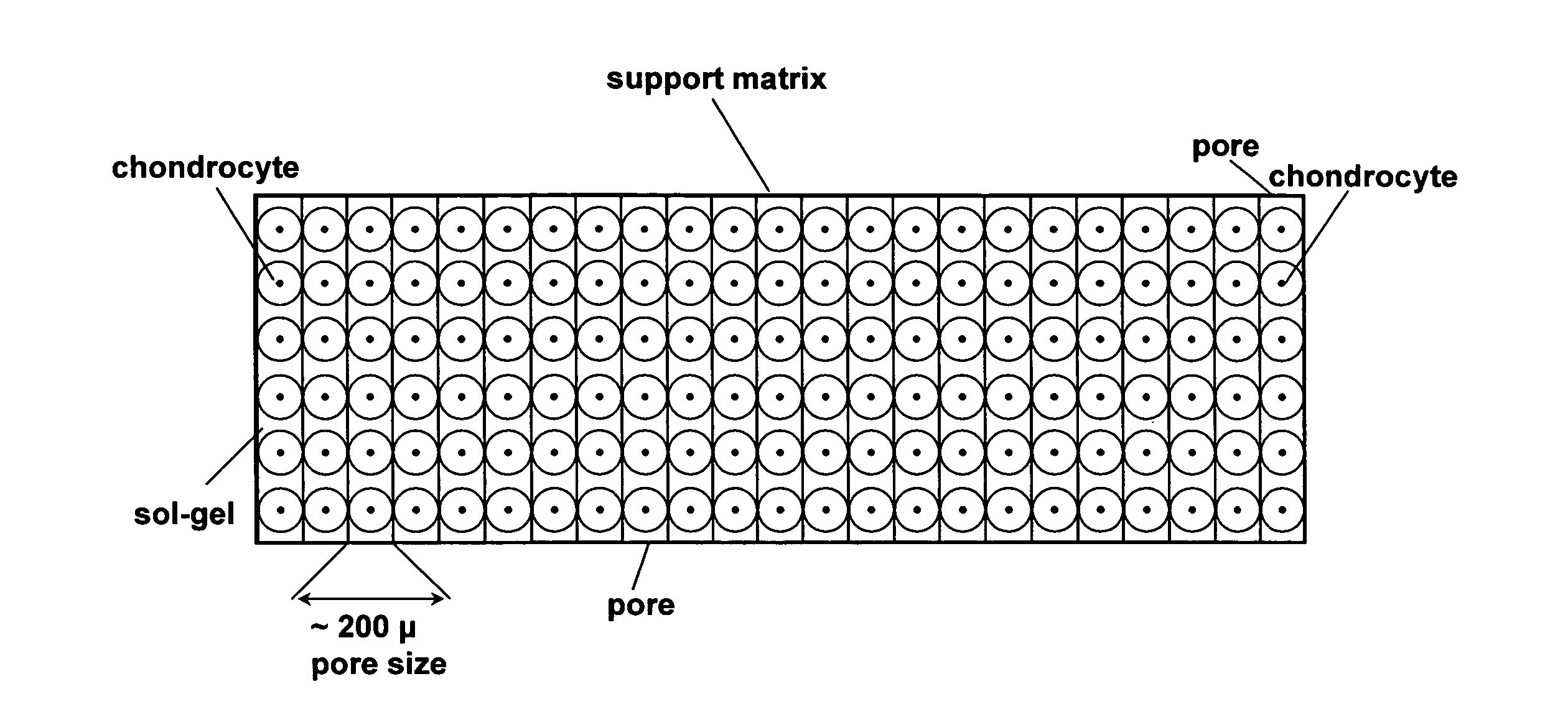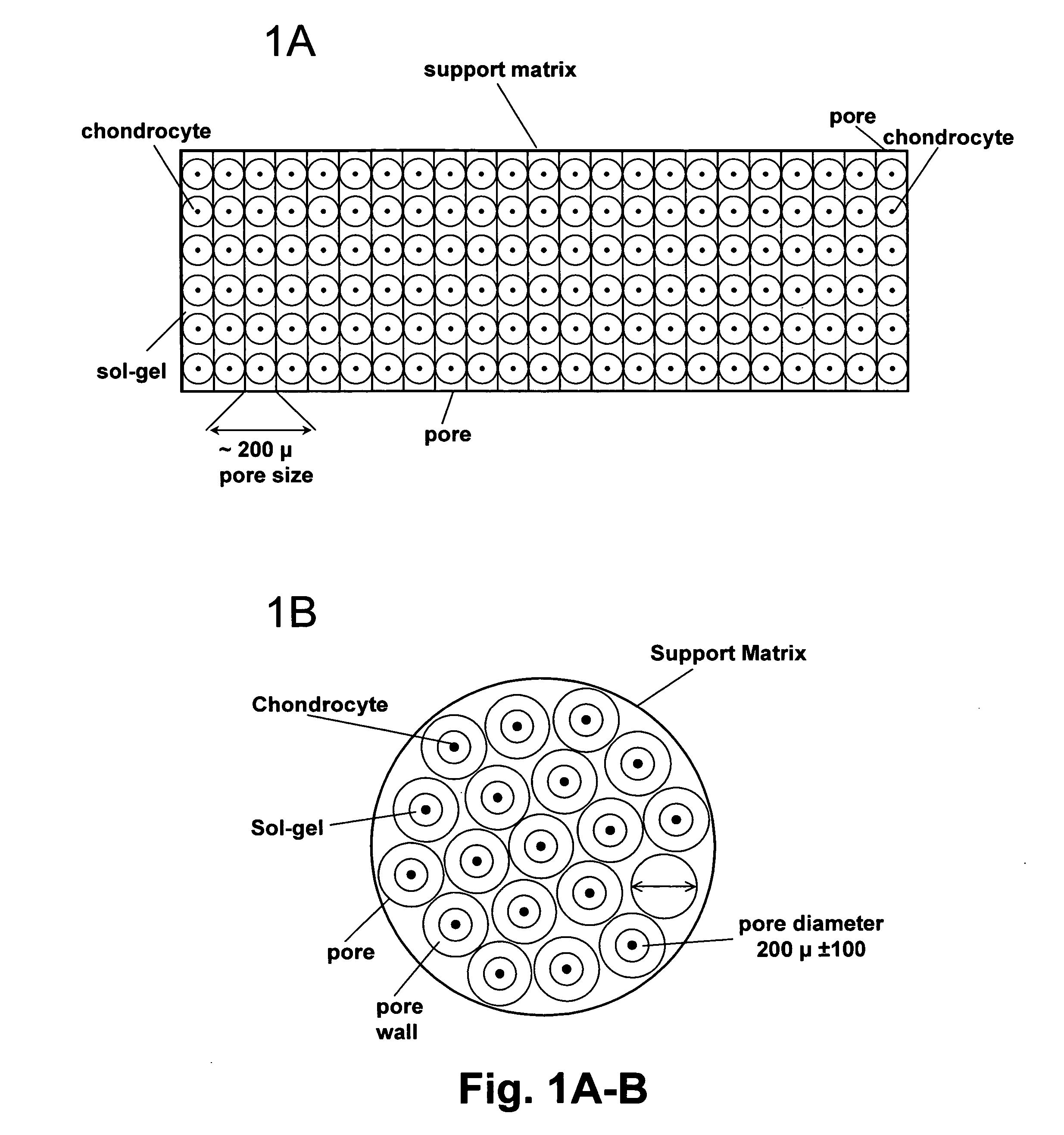Cell-support matrix having narrowly defined uniformly vertically and non-randomly organized porosity and pore density and a method for preparation thereof
a cell-support matrix and uniform structure technology, applied in the direction of skeletal/connective tissue cells, ligaments, prostheses, etc., can solve the problems of uneven and uncontrolled porosity, uncontrollable parameters of the above-described structure, and sterically unstable structures
- Summary
- Abstract
- Description
- Claims
- Application Information
AI Technical Summary
Benefits of technology
Problems solved by technology
Method used
Image
Examples
example 1
Preparation of the Collagen-Based Matrix
[0180] This example describes one exemplary method for preparation of the collagen-based matrix.
[0181] Type I collagen is dissolved in a formic acid buffer at pH 4.8 and its concentration is adjusted to about 5.2 mg / ml. The solution is subjected to a vortical shearing for 10 seconds at 10 dynes per cm. The sheared peptides is then equilibrated in nitrogen gas for 30 minutes at 4° C. to displace air. Neutralization is carried out in a vapor of 0.3% ammonia over a 24 hour period. The solution is then subjected to freezing at −40° C. over a period of 2 hours. Water is removed by exposing the frozen solution to an anhydrous atmosphere at 37° C. for 24 hours.
[0182] The organization of the newly synthesized cartilage specific matrix within the porous type I collagen is visualized and quantified using immunohistochemical methods and matrix-specific gene expression quantified by in situ mRNA hybridization.
example 2
Preparation of Collagen-Based Matrix
[0183] This example illustrates another exemplary method for preparation of the collagen-based matrix. 300 grams of a 1% aqueous atelocollagen solution (VITROGEN®), maintained at pH 3.0, is poured into a 10×20 cm tray. This tray is then placed in a 5 liter container. A 50 mL open container containing 30 mL of a 3% aqueous ammonia solution is then placed next to the tray, in the 5 liter chamber, containing 300 grams of said 1% aqueous solution of atelocollagen. The 5 liter container containing the open trays of atelocollagen and ammonia is then sealed and left to stand at room temperature for 12 hours. During this period the ammonia gas, released from the open container of aqueous ammonia and confined within the sealed 5 liter container, is reacted with the aqueous atelocollagen resulting in gelling said aqueous solution of atelocollagen.
[0184] The collagenous gel is then washed with water overnight and, subsequently, freeze-dried to yield a spon...
example 3
Effect of Ammonia on Preparation of Porous Honeycomb Scaffold
[0185] This example illustrates a general procedure utilizing ammonia for preparation of porous honeycomb scaffold having substantially the same size and distribution of pores.
[0186] About 30 g collagen solution (concentrations listed in table 1) with a pH of 3.0-4.8 was added to a 100 ml glass beaker. The solution was centrifuged for 5-10 minutes at 800× g to remove air bubbles. After centrifugation the beaker with collagen solution was sealed in a 7.1 dm3 container together with 3% aqueous ammonia. The collagen solution was precipitated in the presence of ammonia gas for 3-14 h, forming vertical cone shaped pores where the diameter increased with the depth. After precipitation the collagen gel was washed with deionized water for 1-3 days in order to remove excess ammonia and formed salts. The washed collagen was then slowly frozen and lyophilized.
PUM
| Property | Measurement | Unit |
|---|---|---|
| pore size | aaaaa | aaaaa |
| volume | aaaaa | aaaaa |
| pressure | aaaaa | aaaaa |
Abstract
Description
Claims
Application Information
 Login to View More
Login to View More - R&D
- Intellectual Property
- Life Sciences
- Materials
- Tech Scout
- Unparalleled Data Quality
- Higher Quality Content
- 60% Fewer Hallucinations
Browse by: Latest US Patents, China's latest patents, Technical Efficacy Thesaurus, Application Domain, Technology Topic, Popular Technical Reports.
© 2025 PatSnap. All rights reserved.Legal|Privacy policy|Modern Slavery Act Transparency Statement|Sitemap|About US| Contact US: help@patsnap.com



